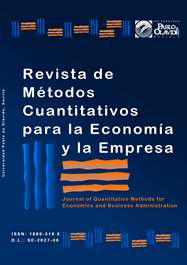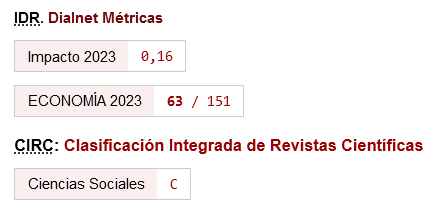Estructuras productivas y desarrollo: el caso de la economía chilena
DOI:
https://doi.org/10.46661/revmetodoscuanteconempresa.2541Palabras clave:
análisis input-output, encadenamientos, cambio estructural, input-output analysis, linkage, structural changeResumen
Esta investigación se inicia con las siguientes interrogantes: ¿existe consistencia entre la identificación de desarrollo y la estructura económica que se posee?; ¿existen parecidos entre economías identificadas con distintos niveles de desarrollo?; y ¿existen economías no desarrolladas con la estructura de una que lo es? Para responder a ellas, se revisan las similitudes de tablas input-output obtenidas desde la OCDE (Mid90, Early00 y Mid00), para posteriormente tomar como caso de estudio a la economía chilena. Las similitudes y cambios se indagan, utilizando un índice de similitud estructural y, comparando sus encadenamientos, se establecen las relaciones que se forman en el proceso de desarrollo. Los resultados revelan que: los indicadores tradicionales son sólo referentes y no categóricos en sus identificaciones de desarrollo; las economías muestran importantes parecidos según su nivel de desarrollo; y existen similitudes estructurales entre economías desarrolladas y la chilena.
Descargas
Citas
Abimanyu, A. (2000): Impact of Agriculture Trade and Subsidy Policy on the Macroeconomy, Distribution, and Environment in Indonesia: A Strategy for Future Industrial Development. The Developing Economies, 38(4), 547-571.
Aroche-Reyes, F. (2006): Trees of the Essential Economic Structures: A Qualitative Input-Output Method. Journal of Regional Science, 46(2), 333-353.
Aroche-Reyes, F. (2002): Structural Transformations and Important Coefficients in the North American Economies. Economic Systems Research, 14(3), 257-273.
Aroche-Reyes, F. (1996): Important Coefficients and Structural Change: A Multi-layer Approach. Economic Systems Research, 8(3), 235-247.
Brown, D.; Riolo, R.; Robinson, D.; North, M. y Rand, W. (2005): Spatial Process and Data Models: Toward Integration of Agent-based Models and GIS. Journal of Geography Systems, 7, 25-47.
Carter, A. (1970): Structural Change in the American Economy. Cambridge: Harvard University Press.
Clark, C. (1940): The Conditions of Economic Progress. Londres: Macmillian.
Clements, B.; Jung, H.-S. y Gupta, S. (2007): Real and Distributive Effects of Petroleum Price Liberalization: The Case of Indonesia. The Developing Economies, 45(2), 220-237.
Fisher, A.G.B. (1939): Production, Primary, Secondary and Tertiary. The Economic Record, 15(1), 24-38.
Forsell, O. (1988): Growth and Changes in the Structure of the Finnish Economy in the 1960s and 1970s. En: M. Ciaschini (ed.), Input-Output Analysis, Nueva York: Chapman and Hall, pp. 287-302.
Fourastié, J. (1949): Le Grand Espoir du XXe Siècle. París: Presses Universitaires de France.
Ghosh, A. (1960): A Note on Leontief Models with Non-Homogeneous Production Functions. Metroeconomica, 12(1), 14-20.
Goldar, B. y Aggarwal, S.Ch. (2012): Informalization of Industrial Labor in India: Effects of Labor Market Rigidities and Import Competition. The Developing Economies, 50(2), 141-169.
Hair, J.; Anderson, R.; Tatham, R. y Black, W. (1999): Análisis Multivariante. Quinta edición. Madrid: Ed. Prentice Hall.
Hewings, G.; Sonis, M.; Guo, J.; Israilevich, P. y Schindler, G. (1998): The Hollowing Out Process in the Chicago Economy: 1975-2011. Geographical Analysis, 30(3), 217-233.
Hewings, G.; Jensen, R.C. y West, G.R. (1988): Fields of Influence of Technological Change in Input-Output Models. Papers in Regional Science, 64(1), 25-36.
Hidalgo, C. y Hausmann, R. (2009): The Building Blocks of Economic Complexity. PNAS, 106(26), 10570-10575.
Hidalgo, C. y Hausmann, R. (2008): A Network View of Economic Development. Developing Alternatives, 12(1), 5-10.
Hidalgo, C.; Klinger, B.; Barabási, A.-L. y Hausmann, R. (2007): The Product Space Conditions the Development of Nations. Science, 317, 482-487.
Hirschman, A. (1958): The Strategy of Economic Development. New Haven: Yale University Press.
Imbs, J. y Wacziarg, R. (2003): Stages of Diversification. The American Economic Journal, 93(1), 63-86.
Kohama, H. y Kajiwara, H. (1986): Structural Change in Steel Trade and International Industrial Adjustments. The Developing Economies, 24(2), 109-130.
Le Masne, P. (1990): Le système productif français face a ses voisins européens. En: E. Archambault y O. Arkhipoff (eds.), La comptabilité nationale face au défi international, París: Economica, pp. 215-231.
Leontief, W. (1963): The Structure of Development. Scientific American, 209(3), 148-166.
Leontief, W. (1951): The Structure of American Economy, 1919-1939. Nueva York: Oxford University Press.
Leontief, W. (1941): The Structure of American Economy, 1919-1929: An Empirical Application of Equilibrium Analysis. Cambridge: Harvard University Press.
Leontief, W. (1936): Quantitative Input and Output Relations in the Economic Systems of the United States. The Review of Economic Statistics, 18(3), 105-125.
McGilvray, J. (1977): Linkages, Key Sectors and Development Strategy. En: W. Leontief (ed.), Structure, System and Economic Policy, Cambridge: Cambridge University Press, pp. 49-56.
Miller, R. y Lahr, M. (2001): A Taxonomy of Extractions. En: M. Lahr y R. Miller (eds.), Regional Science Perspectives in Economic Analysis, Ámsterdam; Elsevier Science, pp. 407-441.
Noguera-Méndez, P. y Semitiel-García, M. (2011): The Embeddedness of the Agro-Food System in the Spanish Interindustrial Structure. International Regional Science Review, 34(1), 34-74.
Parikh, A. (1975): Varius Definitions of Direct and Indirect Requirements in Input-Output Analysis. The Review of Economics and Statistics, 57(3), 375-377.
Rao, V. y Harmston, F. (1979): Identification of Key Sectors in a Region of a Developed Economy. Annals of Regional Science, 13(3), 78-90.
Rasmussen, P. (1956): Studies in Inter-Sectoral Relations. Ámsterdam: North- Holland.
Sánchez-Chóliz, J. y Duarte, R. (2003): Production Chains and Linkage Indicators. Economic Systems Research, 15(4), 481-494.
Sonis, M.; Guilhoto, J.; Hewings, G. y Martins, E. (1995): Linkages, Key Sectors, and Structural Change: Some New Perspectives. The Developing Economics, 33(3), 233-270.
Soza-Amigo, S. (2011): Linkages and Structural Similarities for the Regions of Chile. Economic Analysis Review, 26(2), 81-110.
Soza-Amigo, S. (2007): Análisis estructural input-output: antiguos problemas y nuevas soluciones. Tesis doctoral, Departamento de Economía Aplicada, Universidad de Oviedo, 280 pp.
Soza-Amigo, S. y Aroca, P. (2010): Oportunidades perdidas en Magallanes. Magallania (Chile), 38(2), 89-101.
Soza-Amigo, S. y Ramos, C. (2011): La agregación en las tablas input-output: una revisión desde la perspectiva de las ramas que no se unen. Revista de Economía Mundial, 28, 247-276.
Soza-Amigo, S.; Aroca, P. y Rueda-Cantuche, J.M. (2018): El Desarrollo y los Campos de Influencia. Investigaciones Regionales, 40, 7-34.
Thakur, S. (2011): Fundamental Economic Structure and Structural Change in Regional Economies: A Methodological Approach. Région et Développement, 33, 9-38.
Thakur, S. (2010): Identification of Regional Fundamental Economic Structure (FES): An Input-Output and Field of Influence Approach. En: A.U. Santos-Paulino y G. Wan (eds.), The Rise of China and India: Impacts, prospects and implications, Basingstoke: Palgrave-Macmillan, pp. 138-172.
Thakur, S. (2008): Identification of Temporal Fundamental Economic Structure (FES) of India: An Input- Output and Cross-Entropy Analysis. Structural Change and Economic Dynamics, 19(2), 132-151.
West, G. y Brown, R. (2003): Structural Change, Inter Sectoral Linkages and Hollowing Out in the Taiwanese Economy, 1976-1994. Discussion Paper, No. 327,School of Economics, University of Queensland, 41 pp.
Zakariah, A.R. y Ahmad, E.E. (1999): Sources of Industrial Growth Using the Factor Decomposition Appoach: Malysia, 1978-87. The Developing Economies, 37(2), 162-196.
Descargas
Publicado
Cómo citar
Número
Sección
Licencia
Derechos de autor 2018 Revista de Métodos Cuantitativos para la Economía y la Empresa

Esta obra está bajo una licencia internacional Creative Commons Atribución-CompartirIgual 4.0.
El envío de un manuscrito a la Revista supone que el trabajo no ha sido publicado anteriormente (excepto en la forma de un abstract o como parte de una tesis), que no está bajo consideración para su publicación en ninguna otra revista o editorial y que, en caso de aceptación, los autores están conforme con la transferencia automática del copyright a la Revista para su publicación y difusión. Los autores retendrán los derechos de autor para usar y compartir su artículo con un uso personal, institucional o con fines docentes; igualmente retiene los derechos de patente, de marca registrada (en caso de que sean aplicables) o derechos morales de autor (incluyendo los datos de investigación).
Los artículos publicados en la Revista están sujetos a la licencia Creative Commons CC-BY-SA de tipo Reconocimiento-CompartirIgual. Se permite el uso comercial de la obra, reconociendo su autoría, y de las posibles obras derivadas, la distribución de las cuales se debe hacer con una licencia igual a la que regula la obra original.
Hasta el volumen 21 se ha estado empleando la versión de licencia CC-BY-SA 3.0 ES y se ha comenzado a usar la versión CC-BY-SA 4.0 desde el volumen 22.










